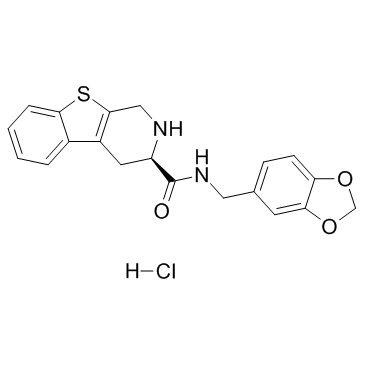AP521 |
| رقم الكتالوجGC31134 |
AP521 هو ناهض لمستقبلات الإنسان 5-HT1A مع IC50 من 94 نانومتر
Products are for research use only. Not for human use. We do not sell to patients.

Cas No.: 151227-08-6
Sample solution is provided at 25 µL, 10mM.
AP521 is an agonist of human 5-HT1A receptor with an IC50 of 94 nM.
AP521 is an agonist of human 5-HT1A receptor with IC50s of 135, 94, 254, 5530, 418, 422 and 198 nM for 5-HT1A (rat), 5-HT1A (human), 5-HT1B (rat), 5-HT1B (human), 5-HT1D (human), 5-HT5a (human) and 5-HT7 (rat), respectively. AP521 also decreases the forskolin-induced cAMP accumulation from 10 nM to 10 μM[1].
AP521 significantly increases the number of shock acceptances [F(5,105)=4.46, P<0.01] at doses between 0.5 to 10 mg/kg. Oral administration of AP521 at 3 and 10 mg/kg significantly decreases freezing time [F(3,60)=2.89, P<0.05]. AP521 significantly increases the time spent on the open arms by approximately 2-fold as compare to the vehicle treated group [F(3, 36)=4.21, P<0.05 for AP521]. The anxiolytic-like effect of AP521 appears to be dose-related. AP521 significantly increases the extracellular 5-HT level of the medial prefrontal cortex (mPFC) at 10 mg/kg from 0.5 to 1 h after administration. AP521 at 3 mg/kg tends to increase the extracellular 5-HT level, however, this increase is not significant[1].
[1]. Kasahara K, et al. The effects of AP521, a novel anxiolytic drug, in three anxiety models and on serotonergic neural transmission in rats. J Pharmacol Sci. 2015 Jan;127(1):109-16.
Average Rating: 5 (Based on Reviews and 9 reference(s) in Google Scholar.)
GLPBIO products are for RESEARCH USE ONLY. Please make sure your review or question is research based.
Required fields are marked with *




















